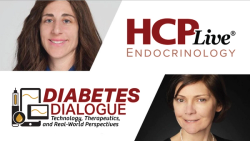
OR WAIT null SECS
EYP-1901 Implant Extends Duration of Wet AMD Treatment, with Avni Finn, MD, MBA
The new, bioerodible intravitreal implant, which periodically releases the tyrose kinase inhibitor vorolanib, may be capable of reducing treatment burden for at least 6 months.
According to results from the DAVIO 2 trial, a single dose of EYP-1901 carrying vorolanib with specific supplementation substantially reduced treatment burden in patients with wet age-related macular degeneration (AMD) relative to pre-trial experiences, when compared to aflibercept.1
Presented at the 43rd Annual Scientific Meeting of the American Society of Retina Specialists in Long Beach, CA, the DAVIO 2 trial was a phase 2 multicenter, prospective, randomized, double-masked clinical study of EYP-1901’s efficacy versus aflibercept every 8 weeks (Q8W).1
HCPLive sat down with the study’s lead researcher, Avni Finn, MD, MBA, associate professor of ophthalmology, vitreoretinal diseases, and surgery at Vanderbilt Eye Institute, to discuss her presentation and the rationale behind searching for dose extension in wet AMD.
“I think that, when we look at where we want new therapies in wet macular degeneration, one of the areas of interest and also need is really in decreasing treatment burden and getting more durable therapies out there,” Finn told HCPLive.
EYP-1901 is a bioerodible, sustained-release intravitreal insert, made to dispense vorolanib, a selective tyrose kinase inhibitor (TKI). Vorolanib blocks signaling from all isoforms of VEGF for ≥6 months. Vorolanib has been shown to provide a superior objective response rate and progression-free survival when combined with everolimus as a 2nd-line therapy for patients with advanced or metastatic renal cell carcinoma.1,2
Finn and colleagues collected patients with previously treated wet AMD, randomizing them to receive aflibercept 2mg monthly for 3 leading doses followed by either aflibercept 2mg Q8W or 1 injection of EYP-1901 2 or 3 mg. Each patient was assessed for supplemental injections using prespecified anatomic and best-corrected visual acuity (BCVA) criteria – supplementation per investigator discretion was allowed.1
DAVIO 2’s primary endpoint was average BCVA change from baseline to week 28/32. Secondary endpoints included safety, proportion of eyes without supplemental injections, BCVA through 56 weeks, and mean change in central subfield thickness (CST).1
The trial ultimately included 156 patients: 50 were assigned to receive EYP-1901 2mg, 52 received EYP-1901 3mg, and 54 received aflibercept Q8W. Each patient in the EYP-1901 cohorts had received a mean of 4.8 and 4.9 anti-VEGF injections/6 months (2mg cohort and 3 mg cohort, respectively). However, those assigned to the EYP-1901 arms received <1 anti-VEGF injection in 6 months on average.1
The patients receiving EYP-1901 required a mean of .55 and .73 supplemental aflibercept injections/6 months in the 2mg and 3mg cohorts, respectively (Week 8-32). This represents an 88% and 85% reduction in treatment burden relative to pre-trial. Additionally, 63% of the EYP-1901-treated eyes did not require supplemental injection in either cohort. CST and BCVA were maintained on average throughout the trial in all 3 arms.1
Investigators did note, however, that patients with >4 years of disease duration received slightly more supplemental injections than those with shorter duration (mean [standard deviation [SD]] supplemental injections week 8 up to week 32 by pre-trial disease duration, EYP-1901 doses pooled, ≤48 [n = 85] vs >48 [n = 17] months, .54 [.87] versus .77 [.93]). There was no clear difference between EYP-1901-treated patients with disease duration ≤9 (n = 36) vs >9 (n = 66) months or ≤17 (n = 50) versus >17 (n = 52) months.1
Finn also spoke to HCPLive regarding the potential for similar TKI-based treatments in ophthalmology in the future.
“I think things like TKIs are going to be a game changer for us,” Finn said. “Our patients with wet macular degeneration are elderly, they have trouble getting to appointments, they oftentimes need somebody to accompany them to appointments, which means somebody else has to take a day off work to bring them in. Putting in something that is sustained release and can really give patients more durability…it’s really going to change the burden of coming in for regular visits, for regular injections.”
LUGANO and LUCIA, 2 phase 3 studies investigating EYP-1901 in treatment-naïve patients with redosing at 6-month intervals, are currently underway.1
Editor's Note: Finn reports disclosures with AbbVie, Genentech, Apellis, and Iveric Bio.
References
1: Finn A, Ribeiro R. Treatment Burden in Wet Age-Related Macular Degeneration Treated with EYP-1901 vs Aflibercept in DAVIO 2, a Phase 2 Clinical Trial. Abstract presented at the 43rd Annual Scientific Meeting of the American Society of Retina Specialists in Long Beach, CA, July 30-August 2, 2025.
2: Sheng X, Ye D, Zhou A, et al. Efficacy and safety of vorolanib plus everolimus in metastatic renal cell carcinoma: A three-arm, randomised, double-blind, multicentre phase III study (CONCEPT). Eur J Cancer. 2023;178:205-215. doi:10.1016/j.ejca.2022.10.025
Related Content:


